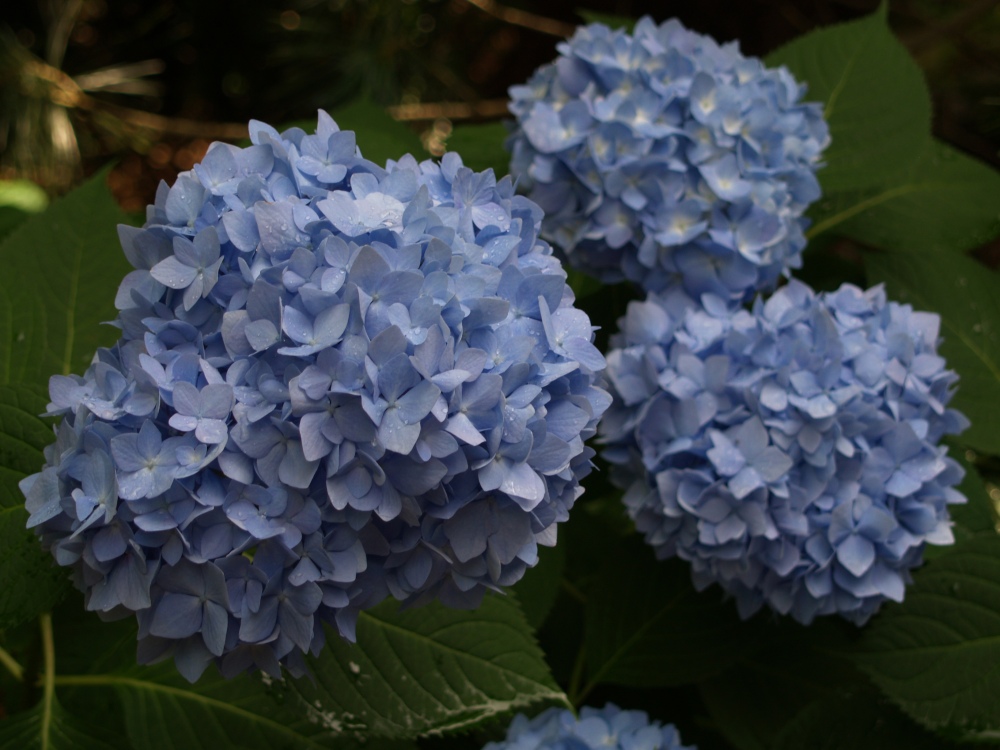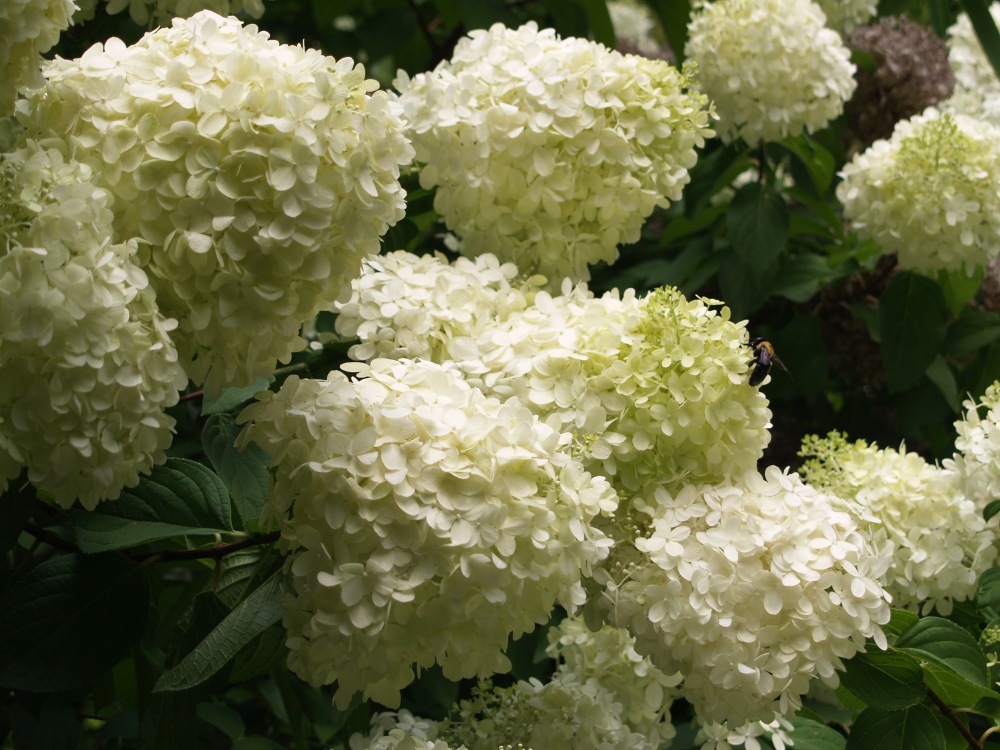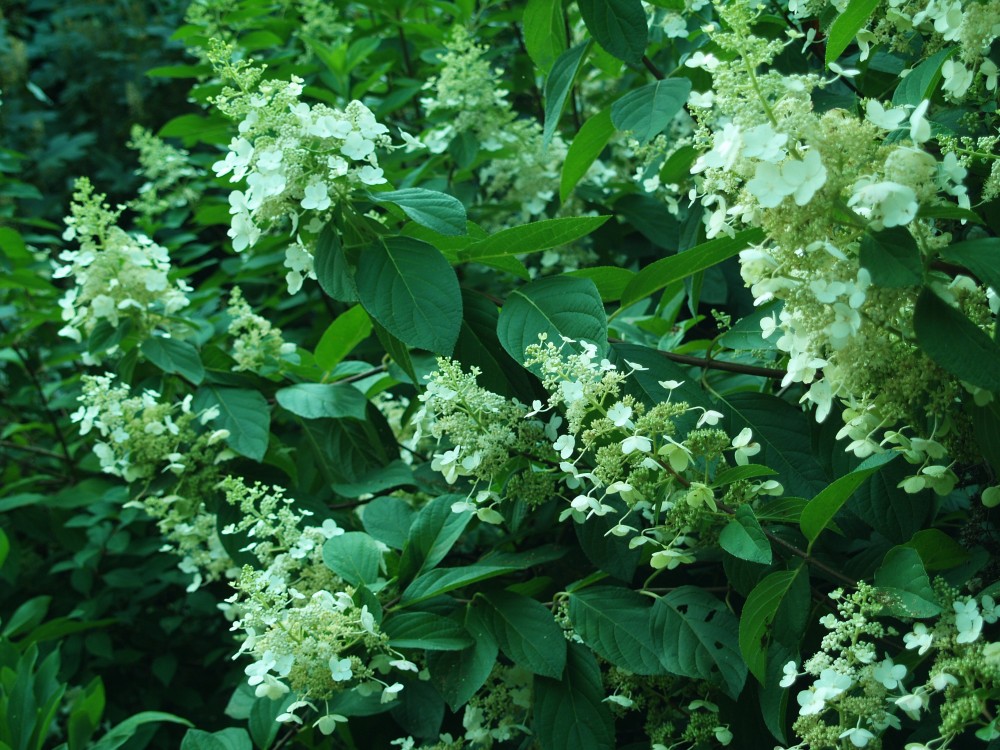I grew the smooth hydrangea ‘Annabelle’ (Hydrangea arborescens ‘Annabelle’, below) in a previous garden with reasonable success, but had no inclination to plant another when this new garden was begun twenty some years ago. The large white blooms were striking, but the lower branches flopped into the mud whenever it rained, and often did not regain their form until the flowers faded.
A few years ago I planted another smooth hydrangea, ‘Incrediball’, to evaluate since it was given significant marketing, but it has been mostly a disappointment, and I’m pleased that it was relegated to a corner where I barely pay any attention. The flowers are significantly smaller than promised in marketing photos, and the foliage of smooth hydrangeas is quite unremarkable, so there seems little purpose in planting them. At least, I’m pleased not to have fallen for the overblown hype for the sad, pink flowered ‘Invincible Spirit’, which has proven to perform poorly for nurseries, and only passably for gardeners.
Certainly, there must be better performing choices to feature in a breast cancer campaign, and it’s unfortunate that the breeder promoted these very average shrubs. No doubt, there are gardens where these perform admirably, but none that I’ve seen have done so, and the newer introductions appear not to be an improvement over the old time ‘Annabelle’ at all.
In early August, the reblooming mophead hydrangeas (Hydrangea macrophylla, above) are resting through the heat of summer. The huge blue and white flowers from late spring have faded slightly, though they remain ornamental enough that I would not consider pruning them off. Depending on how long summer’s heat stretches into September, the hydrangeas will reset buds and there will be flowers again in early autumn (and sometimes very late summer).
The best of the summer bloomers are panicled hydrangeas, and these are considerable improvements over the old PeeGee hydrangea (Hydrangea paniculata ‘Grandiflora’) in my first garden that flopped about even when the blooms were dry. Today, there are a dizzying number of panicled hydrangeas, and most are exceptional plants, including the delightful ‘Limelight’ (Hydrangea paniculata ‘Limelight, above) with light green flowers that turn to creamy white.
Unfortunately, I planted ‘Limelight’ long after prime spots in the garden were taken, and with its large size I was forced to locate it far at the back of the garden where it is crowded by an overhanging yellow leafed redbud and the neighbor’s bald cypress. As things have grown more cluttered, ‘Limelight’ cannot be seen without maneuvering around many shrubs and through muddy patches, so now I assume it’s flowering, but it’s too wet to get back there to confirm it.
The equally large growing ‘Tardiva’ hydrangea (above) was planted long before ‘Limelight’, and so it was given more prominent placement. Though newer varieties have showier blooms, ‘Tardiva’ remains a splendid shrub, with flowers that persist for a month or longer in late summer. By comparison to newly introduced panicled hydrangeas, the blooms are skimpy, but I’ve no regrets. There is only so much space in a garden for shrubs of this size, and ‘Tardiva’ is as good as any.
In the past few years I’ve had a few seedlings pop up from ‘Tardiva’ that appear similar in growth and flower, but of course most of these are growing under and around other valued plants so they must be weeded out before they grow too large. One has been pruned to a single trunk so that it hovers over a blue flowered hydrangea, but within a few years it will grow too large to coexist and it will need to be chopped out. As the neighboring Joe Pye weed has faded, the hoards of butterflies have simply moved a few feet over into ‘Tardva’ and the seedling. Here, they float from one flower to another for hours, content not to explore any further into the garden.
My endless summer hydrangeas have been a big disappointment, but the oakleafs are awesome. I don’t think I’ll ever plant any other type of hydrangea again.
I’ve found Endless Summer to be a dependable bloomer in my garden in half shade or more. In deeper shade the mophead hydrangeas will have only scattered blooms. There are a number of recently introduced reblooming (remontant) hydrangeas, but one of the best is a non-patented, non-branded hydrangea, ‘Penny Mac’. In my garden it produces just as many flowers over the same duration as Endless Summer, and because it’s not trademarked it is less expensive.
I have a feeling the problem in my situation might be too much sun. I plan to move them to a half-shade spot this fall and see how that goes. Penny Mac sounds interesting…I’ll look for it.
A couple of years ago I planted three tree-form hydrangea paniculata “pink diamond” as a screen at the back of my yard. Some sources say this cultivar is as big as other panicle hyrangeas (i.e., should mature at 10-12 ft.) but others seem to say it is a smaller cultivar that only grows to 5-6′ (roughly their size now). Do you have any experience or insight with this cultivar?
Thank you for this blog, by the way. It’s far and away my favorite.